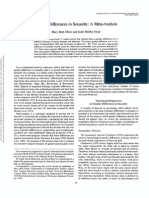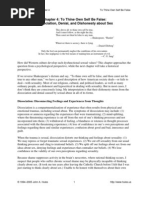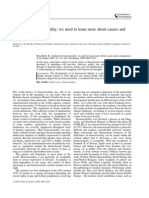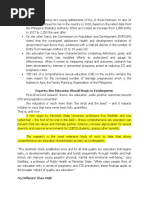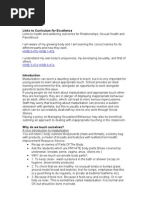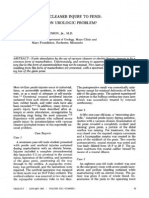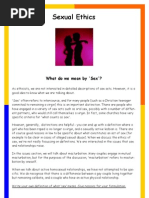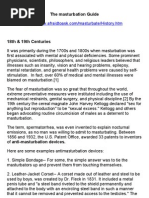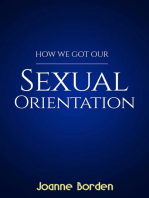AJPH - Sexual Behaviour in The Human Male
AJPH - Sexual Behaviour in The Human Male
Uploaded by
el_papi98Copyright:
Available Formats
AJPH - Sexual Behaviour in The Human Male
AJPH - Sexual Behaviour in The Human Male
Uploaded by
el_papi98Original Title
Copyright
Available Formats
Share this document
Did you find this document useful?
Is this content inappropriate?
Copyright:
Available Formats
AJPH - Sexual Behaviour in The Human Male
AJPH - Sexual Behaviour in The Human Male
Uploaded by
el_papi98Copyright:
Available Formats
VOICES FROM THE PAST
Sexual Behavior in the Human Male
| Alfred C. Kinsey, Wardell R. Pomeroy, and Clyde E. Martin. Sexual
Behavior in the Human Male. Philadelphia, Pa: W.B. Saunders: 1948: 610-666.
HOMOSEXUAL OUTLET
[A] CONSIDERABLE PORTION OF THE population, perhaps the major portion of the male population, has at least some homosexual experience between adolescence and old age. In addition, about 60 per cent of the pre-adolescent boys engage in homosexual activities, and there is an additional group of adult males who avoid overt contacts but who are quite aware of their potentialities for reacting to other males. The social significance of the homosexual is considerably emphasized by the fact that both Jewish and Christian churches have considered this aspect of human sexuality to be abnormal and immoral. Social custom and our AngloAmerican law are sometimes very severe in penalizing one who is discovered to have had homosexual relations. . . . It is, therefore, peculiarly difficult to secure factual data concerning the nature and the extent of the homosexual in Western European or American cultures, and even more difficult to find strictly objective presentations of such data as are available. . . . Until the extent of any type of human behavior is adequately known, it is difficult to assess its significance, either to the individuals who are involved or to society as a whole; and until the extent of the homosexual is known, it is practically impossible to understand its biologic or social origins. It is one thing if we are dealing with a type of activity that is unusual, without precedent among other animals, and restricted to peculiar types of individuals within the human population.
Photo of Alfred C. Kinsey, DSc, courtesy of The Kinsey Institute for Research in Sex, Gender, and Reproduction Inc.
894 | Voices From the Past
American Journal of Public Health | June 2003, Vol 93, No. 6
VOICES FROM THE PAST
It is another thing if the phenomenon proves to be a fundamental part, not only of human sexuality, but of mammalian patterns as a whole.
DEFINITION
For nearly a century the term homosexual in connection with human behavior has been applied to sexual relations, either overt or psychic, between individuals of the same sex. Derived from the Greek root homo rather than from the Latin word for man, the term emphasizes the sameness of the two individuals who are involved in a sexual relation. The word is, of course, patterned after and intended to represent the antithesis of the word heterosexual, which applies to a relation between individuals of different sexes. . . . It is amazing to observe how many psychologists and psychiatrists have . . . come to believe that homosexual males and females are discretely different from persons who merely have homosexual experience, or who react sometimes to homosexual stimuli. Sometimes such an interpretation allows for only two kinds of males and two kinds of females, namely those who are heterosexual and those who are homosexual. But as subsequent data . . . will show, there is only about half of the male population whose sexual behavior is exclusively heterosexual, and there are a few percent who are exclusively homosexual. Any restriction of the term homosexuality to individuals who are exclusively so demands, logically, that the term heterosexual be applied only to those individuals who are exclusively heterosexual; and this makes no allowance for the
nearly half of the population which has had sexual contacts with, or reacted psychically to, individuals of their own as well as of the opposite sex. Actually, of course, one must learn to recognize every combination of heterosexuality and homosexuality in the histories of various individuals. It would encourage clearer thinking on these matters if persons were not characterized as heterosexual or homosexual, but as individuals who have had certain amounts of heterosexual experience and certain amounts of homosexual experience. Instead of using these terms as substantives which stand for persons, or even as adjectives to describe persons, they may better be used to describe the nature of the overt sexual relations, or of the stimuli to which an individual erotically responds.
PREVIOUS ESTIMATES OF INCIDENCE
Satisfactory incidence figures on the homosexual cannot be obtained by any technique short of a carefully planned population survey. The data should cover every segment of the total population. . . . In order to secure data that have any relation to the reality, it is imperative that the cases be derived from as careful a distribution and stratification of the sample as the public opinion polls employ, or as we have employed in the present study. . . .
INCIDENCE DATA IN PRESENT STUDY
The statistics given throughout this volume on the incidence of homosexual activity, and the statistics to be given in the pres-
ent section of this chapter, are based on those persons who have had physical contacts with other males, and who were brought to orgasm as a result of such contacts. By any strict definition such contacts are homosexual, irrespective of the extent of the psychic stimulation involved, of the techniques employed, or of the relative importance of the homosexual and the heterosexual in the history of such an individual. These are not data on the number of persons who are homosexual, but on the number of persons who have had at least some homosexual experience. . . . In these terms (of physical contact to the point of orgasm), the data in the present study indicate that at least 37 percent of the male population has some homosexual experience between the beginning of adolescence and old age. This is more than one male in three of the persons that one may meet as he passes along a city street. Among the males who remain unmarried until the age of 35, almost exactly 50 per cent have homosexual experience between the beginning of adolescence and that age. . . . These figures are, of course, considerably higher than any which have previously been estimated. . . . We ourselves were totally unprepared to find such incidence data when this research was originally undertaken. Over a period of several years we were repeatedly assailed with doubts as to whether we were getting a fair cross section of the total population or whether a selection of cases was biasing the results. It has been our experience, however, that each new group into which we have gone has pro-
June 2003, Vol 93, No. 6 | American Journal of Public Health
Voices From the Past | 895
VOICES FROM THE PAST
Alfred C. Kinsey:
A Pioneer of Sex Research
ONE OF THE MOST INFLUENTIAL Americans of the 20th century, Alfred Charles Kinsey conducted landmark studies of male and female sexual behavior that helped usher in the sexual revolution of the 1960s and 1970s. He was born in Hoboken, NJ, on June 23, 1894, the son of Alfred Seguine Kinsey and Sarah Ann Charles. His father, a zealously religious and intimidating man, and a teacher at Stevens Institute of Technology, insisted that his son put aside his early interest in biology and instead enroll in Stevens to study engineering. After 2 lackluster years, Alfred rebelled and left for Bowdoin College in Maine, where he enrolled as a biology student. Father and son never reconciled; when Alfred graduated with high honors in 1916, his father refused to attend commencement.1 Alfred became a student of applied biology at Harvard, where he came under the influence of William Morton Wheeler, an eminent field biologist, staunch Darwinian, and confidant of the irreverent H. L. Mencken. With Wheeler as his mentor, Kinsey jettisoned most of his religious ideasalthough not all of his repressive upbringingand em-
barked on a massive and meticulous Darwinian case study of the evolutionary taxonomy of the gall wasp. After identifying several new species, Kinsey received his doctor of science degree in 1919 and joined the faculty of Indiana University the following year. In 1924, he married Clara Bracken McMillen, then an outstanding chemistry student at Indiana University. Alfred and Clara had 4 children, 3 of whom survived into adulthood. Kinsey advanced up the academic ranks, becoming full professor in 1929.2 In 1936, he published The Gall Wasp Genus Cynips: A Study of the Origin of Species in 1930 and The Origin of Higher Categories in Cynips. Although both were well received by specialists, Kinsey was deeply disappointed that he was not offered a professorship at a more prestigious university. Perhaps because of this disappointment, Kinsey made an unusual career move in 1938: he agreed to lead a team-taught course on marriage and the family instituted in response to a student petition. High points of the course were Kinseys illustrated lectures on the biology of sexual stimulation, the mechanics of in-
tercourse, and the techniques of contraception, as were his spirited denunciations of repressive laws and social attitudes. He also attempted to replace conventional ideas of normal sexual behavior with a new biological definition: nearly all the so-called sexual perversions fall within the range of biological normality.3(p333) As his recent biographer James H. Jones observes, Kinsey was using the marriage course to transform his private struggle against Victorian morality into a public crusade and to protest issues that had bedeviled him for decades.3(p335) The Indiana students responded enthusiastically, and his course enrollments grew to 400 by 1940. Kinsey now shifted his research focus as well, transferring his obsessive concern with variation among gall wasps to the varieties of human sexual experience. He required students in his marriage course to have private conferences in which he took their sexual histories. On weekends and vacations, he conducted similar interviews in nearby communities, and later in such cities as Gary, Chicago, St. Louis, and Philadelphia. Kinsey received research support from the National
vided substantially the same data. Whether the histories were taken in one large city or another, whether they were taken in large cities, in small towns, or in rural areas, whether they came from one college or from another, a church school or a state university or some private institution, whether they came from one part of the country or from another, the incidence data on the homosexual have been more or less the same. . . .
896 | Voices From the Past
THE HETEROSEXUALHOMOSEXUAL BALANCE
Concerning patterns of sexual behavior, a great deal of the thinking done by scientists and laymen alike stems from the assumption that there are persons who are heterosexual and persons who are homosexual, that these two types represent antitheses in the sexual world, and that there is only an insignificant class of bisexuals who occupy
an intermediate position between the other groups. It is implied that every individual is innatelyinherentlyeither heterosexual or homosexual. It is further implied that from the time of birth one is fated to be one thing or the other, and that there is little chance for one to change his pattern in the course of a lifetime. It is quite generally believed that ones preference for a sexual partner of one or the other
sex is correlated with various physical and mental qualities, and with the total personality which makes a homosexual male or female physically, psychically, and perhaps spiritually distinct from a heterosexual individual. It is generally thought that these qualities make a homosexual person obvious and recognizable to any one who has a sufficient understanding of such matters. Even psychiatrists discuss the homosexual
American Journal of Public Health | June 2003, Vol 93, No. 6
VOICES FROM THE PAST
Research Council and the Rockefeller Foundation, which allowed him to hire research assistants, expand the geographic scope of his work, and found the Institute of Sex Research at Indiana University in 1947. In January 1948, Kinsey and his collaborators published Sexual Behavior in the Human Male, the source of the excerpt reprinted here. It made the bestseller list within 3 weeks, despite its 804 pages, generally dry scientific style, and ponderous weight of statistics, tables, and graphs. By mid-March, it had sold 200 000 copies. The book, based on over 5000 sexual histories, provided a series of revelations about the prevalence of masturbation, adulterous sexual activity, and homosexuality. One religious leader attacked Kinsey for publishing the most anti-religious book of our times.4 Some criticized his methods (and conclusions) because of inadequate sampling techniques; others extravagantly praised him as another Galileo or Darwin. Kinseys next major project was Sexual Behavior in the Human Female, published in 1953. Based on almost 6000 sexual histories, this book con-
tained many revelations about such matters as womens masturbatory practices, premarital sexuality, and orgasmic experiences. As before, Kinsey documented an enormous gap between social attitudes and actual practices. Also as before, the book was a media sensation, but this time the counterattack was so ferociousincluding a congressional investigation of his financial supportthat the Rockefeller Foundation terminated its funding. Kinseys health deteriorated under the strain of public attack and uncertainty about the future of his institute. He suffered from heart disease and, after a brief hospitalization for pneumonia, died in Bloomington on August 25, 1956. In his own mind, his principal legacy was to have brought scientific rigor to the study of human sexuality. But as his biographer James H. Jones points out, Kinsey was not only a scientist; he was a reformer who sought to rid himself of his personal sexual demons, while at the same time revolutionizing the repressive society in which he had grown up:
His formative years were spent in a home and in a nation where many middle-
class parents enshrouded sex in shame, heaping more than enough guilt on young people to mangle and twist them. This was particularly true for those like Kinsey who aspired but failed to achieve moral perfection. His great accomplishment was to take his pain and suffering and use it to transform himself into an instrument of social reform, a secular evangelist who proclaimed a new sensibility about human sexuality.3(p772)
NY: Oxford University Press; 1999: 944949. 2. DuBois W. E. B. The Philadelphia Negro: A Social Study. New York, NY: Benjamin Blom; 1899. 3. Hoffman FL. Race Traits and Tendencies of the American Negro. New York, NY: American Economic Association; 1896. 4. Rampersad A. DuBois, William Edward Burghardt. In: Garraty JA, ed. Dictionary of American Biography. Suppl. 7, 19611965. New York, NY: Charles Scribners Sons; 1981:200205.
Theodore M. Brown Elizabeth Fee
About the Authors
Theodore M. Brown is with the Departments of History and of Community and Preventive Medicine at the University of Rochester, NY. Elizabeth Fee is with the History of Medicine Division, National Library of Medicine, National Institutes of Health, Bethesda, Md. Requests for reprints should be sent to Theodore M. Brown, PhD, Department of History, University of Rochester, Rochester, NY 14627 (e-mail: theodore.brown@ urmc.rochester.edu). This contribution was accepted October 9, 2002.
References
1. Holt TC. W E. B. DuBois. In: Garraty JA, Carnes MC, eds. American National Biography. Vol 6. New York,
personality and many of them believe that preferences for sexual partners of a particular sex are merely secondary manifestations of something that lies much deeper in the totality of that intangible which they call the personality. . . . The histories which have been available in the present study make it apparent that the heterosexuality or homosexuality of many individuals is not an all-or-none proposition. It is true
that there are persons in the population whose histories are exclusively heterosexual, both in regard to their overt experience and in regard to their psychic reactions. And there are individuals in the population whose histories are exclusively homosexual, both in experience and in psychic reactions. But the record also shows that there is a considerable portion of the population whose members have combined, within their individ-
ual histories, both homosexual and heterosexual experience and/or psychic responses. There are some whose heterosexual experiences predominate, there are some whose homosexual experiences predominate, there are some who have had quite equal amounts of both types of experience. . . . Males do not represent two discrete populations, heterosexual and homosexual. The world is not to be divided into sheep
and goats. Not all things are black nor all things white. It is a fundamental of taxonomy that nature rarely deals with discrete categories. Only the human mind invents categories and tries to force facts into separated pigeonholes. The living world is a continuum in each and every one of its aspects. The sooner we learn this concerning human sexual behavior the sooner we shall reach a sound understanding of the realities of sex. . . .
Voices From the Past | 897
June 2003, Vol 93, No. 6 | American Journal of Public Health
VOICES FROM THE PAST
SCIENTIFIC AND SOCIAL IMPLICATIONS
In view of the data which we now have on the incidence and frequency of the homosexual, and in particular on its co-existence with the heterosexual in the lives of a considerable portion of the male population, it is difficult to maintain the view that psychosexual reactions between individuals of the same sex are rare and therefore abnormal or unnatural, or that they constitute within themselves evidence of neuroses or even psychoses. . . . The very general occurrence of the homosexual in ancient Greece, and its wide occurrence today in some cultures in which such activity is not as taboo as it is in our own, suggests that the capacity of an individual to respond erotically to any sort of stimulus, whether it is provided by another person of the same or of the opposite sex, is basic in the
species. That patterns of heterosexuality and patterns of homosexuality represent learned behavior which depends, to a considerable degree, upon the mores of the particular culture in which the individual is raised, is a possibility that must be thoroughly considered before there can be any acceptance of the idea that homosexuality is inherited, and that the pattern for each individual is so innately fixed that no modification of it may be expected within his lifetime. . . .
SOCIAL APPLICATIONS
. . . Social reactions to the homosexual have obviously been based on the general belief that a deviant individual is unique and as such needs special consideration. When it is recognized that the particular boy who is discovered in homosexual relations in school, the business man who is having such activity, and the insti-
tutional inmate with a homosexual record, are involved in behavior that is not fundamentally different from that had by a fourth to a third of all of the rest of the population, the activity of the single individual acquires a somewhat different social significance. . . . The difficulty of the situation becomes still more apparent when it is realized that these generalizations concerning the incidence and frequency of homosexual activity apply in varying degrees to every social level, to persons in every occupation, and of every age in the community. The police force and court officials who attempt to enforce the sex laws, the clergymen and business men and every other group in the city which periodically calls for enforcement of the lawsparticularly the laws against sexual perversion have given a record of incidences and frequencies in the homosexual which are as high
as those of the rest of the social level to which they belong. It is not a matter of the individual hypocrisy whichleads officials with homosexual histories to become prosecutors of the homosexual activity in the community. They themselves are the victims of the mores, and the public demand that they protect those mores. As long as there are such gaps between the traditional custom and the actual behavior of the population, such inconsistencies will continue to exist. . . . The homosexual has been a significant part of human sexual activity ever since the dawn of history, primarily because it is an expression of capacities that are basic in the human animal.
898 | Voices From the Past
American Journal of Public Health | June 2003, Vol 93, No. 6
You might also like
- Exploring The Lived Experience of Problematic Users of Internet Pornography (AOD)Document29 pagesExploring The Lived Experience of Problematic Users of Internet Pornography (AOD)Francesca Palazzolo100% (1)
- Are Wet Dreams Your ProblemDocument4 pagesAre Wet Dreams Your Problemmadhu262No ratings yet
- Expphysiol 1954 sp001049Document2 pagesExpphysiol 1954 sp001049chetantaneja_40No ratings yet
- Gender Differences in Sexuality A Meta Analysis1Document23 pagesGender Differences in Sexuality A Meta Analysis1Miruna MogosNo ratings yet
- Chapter 4: To Thine Own Self Be False: Dissociation, Denial, and Dishonesty About SexDocument15 pagesChapter 4: To Thine Own Self Be False: Dissociation, Denial, and Dishonesty About SexKader SaifulNo ratings yet
- A Boy Discovers His Penis PDFDocument29 pagesA Boy Discovers His Penis PDFagustin cassinoNo ratings yet
- The Formation of The Homosexual IdentityDocument31 pagesThe Formation of The Homosexual IdentityMalcolm RobinsonNo ratings yet
- Perspectives: Gay Men Only?Document3 pagesPerspectives: Gay Men Only?betsyk1No ratings yet
- NHH 00 An Overview of This CourseDocument4 pagesNHH 00 An Overview of This CoursePivaNo ratings yet
- The Sexual SelfDocument30 pagesThe Sexual SelfGilbert BelmisNo ratings yet
- The Anatomy, Histology and Development of The Penis PDFDocument9 pagesThe Anatomy, Histology and Development of The Penis PDFredderdatNo ratings yet
- The PenisDocument6 pagesThe Penisntambik21No ratings yet
- Human Sexual ResponseDocument10 pagesHuman Sexual ResponseRaffy John BinbinNo ratings yet
- Chapter - 4 Factors Affecting Homosexual Orientation & Its ImplicationDocument20 pagesChapter - 4 Factors Affecting Homosexual Orientation & Its ImplicationJelly Mea Vicente TareNo ratings yet
- (Genaro Castro-Vázquez (Auth.) ) Male CircumcisionDocument208 pages(Genaro Castro-Vázquez (Auth.) ) Male CircumcisionJorge Andrés100% (1)
- LgbtqproposalwritingDocument5 pagesLgbtqproposalwritingapi-273124540No ratings yet
- The Bible On The Question of Homosexuality by Innocent Himbaza, Adrien Schenker, Jean-Baptiste Edart Benedict M. Guevin (Trans., Intr.)Document168 pagesThe Bible On The Question of Homosexuality by Innocent Himbaza, Adrien Schenker, Jean-Baptiste Edart Benedict M. Guevin (Trans., Intr.)Victor GafotasNo ratings yet
- The Faking Orgasm Scale For Women: Psychometric PropertiesDocument13 pagesThe Faking Orgasm Scale For Women: Psychometric PropertiesEdit Csányi100% (1)
- Hector's BoysDocument5 pagesHector's BoysparangboiNo ratings yet
- The Political Economy of Gay Sex Under Homonormativity - Bareback, PrEP and Welfare Provision - Society & SpaceDocument17 pagesThe Political Economy of Gay Sex Under Homonormativity - Bareback, PrEP and Welfare Provision - Society & Spacebruno_hortaNo ratings yet
- Adolescent Homosexuality Causes&ConsequencesDocument5 pagesAdolescent Homosexuality Causes&Consequences雲開No ratings yet
- 6+ +sexualityDocument113 pages6+ +sexualityalieraongaco100% (1)
- Inceput Articol DelceaDocument9 pagesInceput Articol DelceaAmalia BondreaNo ratings yet
- Boyhood's Perils and Manhood's CurseDocument50 pagesBoyhood's Perils and Manhood's CurseveveieioNo ratings yet
- Global Sex Sexuality and Sexual Practices Around The WorldDocument12 pagesGlobal Sex Sexuality and Sexual Practices Around The WorldCher LimNo ratings yet
- Experts: Sex Education Should Begin in KindergartenDocument6 pagesExperts: Sex Education Should Begin in KindergartenShin ZhenNo ratings yet
- Portrait of An ExhibitionistDocument15 pagesPortrait of An Exhibitionist116 - Kencana NoorNo ratings yet
- HomosexualityDocument11 pagesHomosexualityvijaya choudharyNo ratings yet
- Human Sexual IntercourseDocument22 pagesHuman Sexual Intercoursetajuddin0786gmailcomNo ratings yet
- Debate On HomosexualsDocument2 pagesDebate On HomosexualsLiQinghuaNo ratings yet
- G-Spot A Modern Gynecological MythDocument4 pagesG-Spot A Modern Gynecological MythKORGANCHNo ratings yet
- MasturbationDocument5 pagesMasturbationharry619No ratings yet
- What Is A Pedophile (Tasawar Abaas)Document17 pagesWhat Is A Pedophile (Tasawar Abaas)Waqas AshrafNo ratings yet
- Am I Normal - A Systematic Review and Construction of Nomograms For Flaccid and Erect Penis Length and Circumference in Up To 15 521 MenlDocument9 pagesAm I Normal - A Systematic Review and Construction of Nomograms For Flaccid and Erect Penis Length and Circumference in Up To 15 521 MenlBlack HoleNo ratings yet
- 13 Crucial Facts About Your PeniDocument3 pages13 Crucial Facts About Your PeniBelal AhmadNo ratings yet
- How Children Are Conditioned by Hardcore PornographyDocument4 pagesHow Children Are Conditioned by Hardcore PornographyLobuscherNo ratings yet
- Male Dyspareunia - UpToDate PDFDocument15 pagesMale Dyspareunia - UpToDate PDFCamilo HernandezNo ratings yet
- Prostate-Induced Orgasms:: A Concise Review Illustrated With A Highly Relevant Case StudyDocument5 pagesProstate-Induced Orgasms:: A Concise Review Illustrated With A Highly Relevant Case StudyDayanaNo ratings yet
- PenisDocument4 pagesPenisckiely91No ratings yet
- Management of Foreskin ConditionsDocument26 pagesManagement of Foreskin ConditionsSarif CassanovaNo ratings yet
- The Average Penis Size PDFDocument11 pagesThe Average Penis Size PDFRandy RobinsonNo ratings yet
- Sex Education in Public Schools:: Sexualization of Children and LGBT IndoctrinationDocument56 pagesSex Education in Public Schools:: Sexualization of Children and LGBT IndoctrinationCarlos GalindoNo ratings yet
- Pornography A Sociobiological Attempt at UnderstandingDocument12 pagesPornography A Sociobiological Attempt at UnderstandingJudith Reisman, Ph.D.No ratings yet
- Sexual Behaviour in Male AnimalsDocument5 pagesSexual Behaviour in Male AnimalsTANVI KOYANDE100% (1)
- Sex BookletDocument14 pagesSex Bookletrocadon100% (1)
- Paternal Masturbation of Profoundly Disabled Son: South African Case StudyDocument32 pagesPaternal Masturbation of Profoundly Disabled Son: South African Case StudyNatassa FerentinouNo ratings yet
- Elephantiasis of Penis and Scrotum PDFDocument3 pagesElephantiasis of Penis and Scrotum PDFtoti1967No ratings yet
- Journal of Human Sexuality, Vol. 5Document164 pagesJournal of Human Sexuality, Vol. 5David C. Pruden100% (3)
- When Victoria Becomes Albert: The Harmful Social Effects of Transgender Legislation: Application of the Principle, #5From EverandWhen Victoria Becomes Albert: The Harmful Social Effects of Transgender Legislation: Application of the Principle, #5Rating: 1 out of 5 stars1/5 (1)
- Child Sexual Abuse and Imprinting The Fraud of Sigmund Freud and The Frommians Too Corrected and Enlarged Versi NDocument16 pagesChild Sexual Abuse and Imprinting The Fraud of Sigmund Freud and The Frommians Too Corrected and Enlarged Versi NHerald Scholarly Open AccessNo ratings yet
- Niños Porno TallerDocument34 pagesNiños Porno TallerRoger Inzunza100% (1)
- The Porn FactorDocument3 pagesThe Porn FactorJudith Reisman, Ph.D.100% (1)
- Fence Sitters: Parents' reactions to sexual ambiguities in their newborn children - מתוך מאמרה של מאירה וייסDocument18 pagesFence Sitters: Parents' reactions to sexual ambiguities in their newborn children - מתוך מאמרה של מאירה וייספרופסור מאירה וייסNo ratings yet
- The Masturbation GuideDocument3 pagesThe Masturbation Guideluisperuscribd100% (1)
- Semen and Seminal Stains (Forensic Chem)Document1 pageSemen and Seminal Stains (Forensic Chem)Dean Mark AnacioNo ratings yet
- Women's Preferences For Penis Size: A New Research Method Using Selection Among 3D ModelsDocument17 pagesWomen's Preferences For Penis Size: A New Research Method Using Selection Among 3D ModelsGustavo FigueroaNo ratings yet



